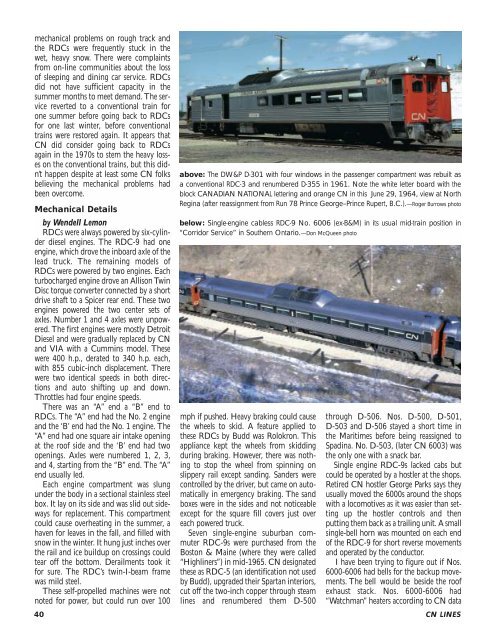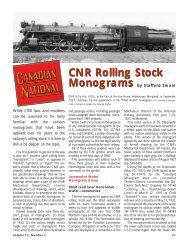CN LINES V12N3 - Canadian National Railways Historical Association
CN LINES V12N3 - Canadian National Railways Historical Association
CN LINES V12N3 - Canadian National Railways Historical Association
You also want an ePaper? Increase the reach of your titles
YUMPU automatically turns print PDFs into web optimized ePapers that Google loves.
mechanical problems on rough track and<br />
the RDCs were frequently stuck in the<br />
wet, heavy snow. There were complaints<br />
from on-line communities about the loss<br />
of sleeping and dining car service. RDCs<br />
did not have sufficient capacity in the<br />
summer months to meet demand. The service<br />
reverted to a conventional train for<br />
one summer before going back to RDCs<br />
for one last winter, before conventional<br />
trains were restored again. It appears that<br />
<strong>CN</strong> did consider going back to RDCs<br />
again in the 1970s to stem the heavy losses<br />
on the conventional trains, but this didn’t<br />
happen despite at least some <strong>CN</strong> folks<br />
believing the mechanical problems had<br />
been overcome.<br />
Mechanical Details<br />
by Wendell Lemon<br />
RDCs were always powered by six-cylinder<br />
diesel engines. The RDC-9 had one<br />
engine, which drove the inboard axle of the<br />
lead truck. The remaining models of<br />
RDCs were powered by two engines. Each<br />
turbocharged engine drove an Allison Twin<br />
Disc torque converter connected by a short<br />
drive shaft to a Spicer rear end. These two<br />
engines powered the two center sets of<br />
axles. Number 1 and 4 axles were unpowered.<br />
The first engines were mostly Detroit<br />
Diesel and were gradually replaced by <strong>CN</strong><br />
and VIA with a Cummins model. These<br />
were 400 h.p., derated to 340 h.p. each,<br />
with 855 cubic-inch displacement. There<br />
were two identical speeds in both directions<br />
and auto shifting up and down.<br />
Throttles had four engine speeds.<br />
There was an “A” end a “B” end to<br />
RDCs. The “A” end had the No. 2 engine<br />
and the ‘B’ end had the No. 1 engine. The<br />
“A” end had one square air intake opening<br />
at the roof side and the ‘B’ end had two<br />
openings. Axles were numbered 1, 2, 3,<br />
and 4, starting from the “B” end. The “A”<br />
end usually led.<br />
Each engine compartment was slung<br />
under the body in a sectional stainless steel<br />
box. It lay on its side and was slid out sideways<br />
for replacement. This compartment<br />
could cause overheating in the summer, a<br />
haven for leaves in the fall, and filled with<br />
snow in the winter. It hung just inches over<br />
the rail and ice buildup on crossings could<br />
tear off the bottom. Derailments took it<br />
for sure. The RDC’s twin-I-beam frame<br />
was mild steel.<br />
These self-propelled machines were not<br />
noted for power, but could run over 100<br />
above: The DW&P D-301 with four windows in the passenger compartment was rebuilt as<br />
a conventional RDC-3 and renumbered D-355 in 1961. Note the white letter board with the<br />
block CANADIAN NATIONAL lettering and orange <strong>CN</strong> in this June 29, 1964, view at North<br />
Regina (after reassignment from Run 78 Prince George–Prince Rupert, B.C.).—Roger Burrows photo<br />
below: Single-engine cabless RDC-9 No. 6006 (ex-B&M) in its usual mid-train position in<br />
“Corridor Service” in Southern Ontario.—Don McQueen photo<br />
mph if pushed. Heavy braking could cause<br />
the wheels to skid. A feature applied to<br />
these RDCs by Budd was Rolokron. This<br />
appliance kept the wheels from skidding<br />
during braking. However, there was nothing<br />
to stop the wheel from spinning on<br />
slippery rail except sanding. Sanders were<br />
controlled by the driver, but came on automatically<br />
in emergency braking. The sand<br />
boxes were in the sides and not noticeable<br />
except for the square fill covers just over<br />
each powered truck.<br />
Seven single-engine suburban commuter<br />
RDC-9s were purchased from the<br />
Boston & Maine (where they were called<br />
“Highliners”) in mid-1965. <strong>CN</strong> designated<br />
these as RDC-5 (an identification not used<br />
by Budd), upgraded their Spartan interiors,<br />
cut off the two-inch copper through steam<br />
lines and renumbered them D-500<br />
through D-506. Nos. D-500, D-501,<br />
D-503 and D-506 stayed a short time in<br />
the Maritimes before being reassigned to<br />
Spadina. No. D-503, (later <strong>CN</strong> 6003) was<br />
the only one with a snack bar.<br />
Single engine RDC-9s lacked cabs but<br />
could be operated by a hostler at the shops.<br />
Retired <strong>CN</strong> hostler George Parks says they<br />
usually moved the 6000s around the shops<br />
with a locomotives as it was easier than setting<br />
up the hostler controls and then<br />
putting them back as a trailing unit. A small<br />
single-bell horn was mounted on each end<br />
of the RDC-9 for short reverse movements<br />
and operated by the conductor.<br />
I have been trying to figure out if Nos.<br />
6000-6006 had bells for the backup movements.<br />
The bell would be beside the roof<br />
exhaust stack. Nos. 6000-6006 had<br />
“Watchman” heaters according to <strong>CN</strong> data<br />
40 <strong>CN</strong> <strong>LINES</strong>



